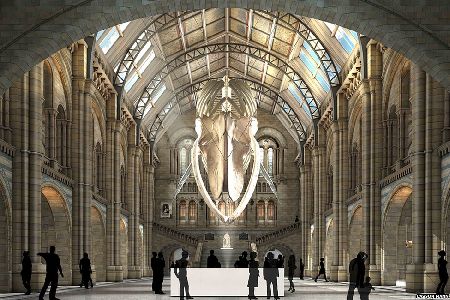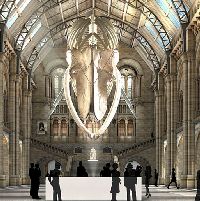
Artist impression of the new entrance exhibit, where the blue whale replaces 'Dippy', the Diplodocus replica
Dr Michael Berenbrink, researcher at the University’s Institute of Integrative Biology in diversity of physiological mechanisms in animals, comments on the Natural History Museum’s decision to make the blue whale the central exhibition of its famous entrance hall, replacing the Diplodocus skeleton that has stood at its doors since the 1970s.
“Judging by the huge queues on every visit to the Natural History Museum, the dinosaur exhibition is arguably the biggest public attraction of the house.
“For me, however, the most exciting place in the museum has always been the whale room. Tucked away in a far corner of the house and seemingly unchanged for decades, this room has beautifully illustrated multiple secondary transitions of mammals back into a more and more aquatic way of life, including seals and sea lions, and the extinct gigantic Steller’s sea cow, culminating in the largest animal of all time – the blue whale.
Controversial
“I welcome the somewhat controversial decision to move the blue whale skeleton into the centre stage of the entrance hall at the Natural History Museum. It helps to emphasise the fact that we know almost as little about this largest of all animals that ever lived as we know about dinosaurs such as Diplodocus.
“It perhaps also symbolizes a shift in the understanding of the role of natural history collections in museums, from keepers of the past to active research, supporting institutions involved in addressing the questions of our time.
“These include tracing the origins of species in the deep past, but extends to understanding their current diversity in form and function and the roles that humans have played in the past and will play in the future to determine their fate.”
To read more about the University’s Institute of Integrative Biology’s research on the whale, please visit: //news.liverpool.ac.uk/2013/06/13/film-study-shows-how-diving-mammals-evolved-underwater-endurance/ and //news.liverpool.ac.uk/2015/01/06/scientists-sequence-genome-longest-lived-mammal/
